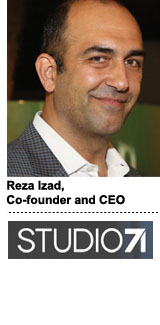
A few years ago, video multichannel networks (MCNs) had the luxury of choice: get access to a large, scaled audience via YouTube or go with a handful of new video upstarts wooing content creators with pricier payouts.
But the digital video landscape has dramatically shifted since, as digital publishers and broadcast nets alike increasingly distribute their own short-form video content through YouTube, Facebook, Snap and other platforms.
“The stakes are a lot higher now than what you originally saw on YouTube where everyone was literally just throwing shit at the wall,” said Reza Izad, the co-founder and CEO of Studio71, the MCN subsidiary of German broadcaster ProSieben. “Now, the projects are larger, and with YouTube Red and Facebook Watch emerging, quality matters more than ever.”
Even so, the opportunity for content creators has never been greater.
Studio71 has evolved into one of the most scaled global MCNs after gaining a number of international broadcast investments.
In addition to ProSieben’s 70% stake in Studio71, the French and Italian broadcasters TF1 and Mediaset also invested $56 million in the company in January to fund Studio71’s European video expansion.
Izad spoke with AdExchanger about what’s next for Studio71’s content and advertising businesses.
AdExchanger: What’s one of your biggest challenges?
REZA IZAD: Anyone can grow their production efforts, but if you don’t deliver a hit, you won’t be in business in eight months.
The reality is, the market that was once the domain of the digital native only is now competing with TV people who see less opportunity in traditional broadcast and who are looking at this space and saying, “Hey, I can do that, too.” We’ve always been striving to do excellent work, but we’ve got to deliver hits into these OTT platforms.
How is Studio71’s business going?
We have a really unique advertising product. We take top-tier local TV short-form and marry it with a premium list of native digital producers and layer in English-language international talent. This has given us a hyperpremium advertising product that’s done well in Germany, and we expect it to do well in France and Italy.
We raised some capital to start local MCNs in partnership with TF1 and Mediaset, and it’s moving along. We’re in year one, so we’re really just operationalizing these businesses. In France, we’re very far along. We have a 400-million-view-per-month network comprised of significant television content from their portfolio.
Where do you see the most upside in advertising?
We have a lot of scale with a very finite amount of creators, so we’re having a lot of high-value ad placement adjacency conversations with brands, and we sell a good deal in media both in the US and globally in Germany and Canada.
The second part is the branded content piece and … then the performance marketing. And everyone always asks, “What’s the ROI?”
When brands have key metrics they’re looking for like clicks, subscriptions and downloads, we’re able to show a ton of conversion there. You still get the “What’s my view count?” requests when it’s a brand talking about lift or other brand effects, but there’s definitely a lot to apply to mainstream brands from the performance marketer’s world.
Given that you have “studio,” in your name, how much content do you create, and when do you rely on the client’s creative agency?
Companies hire us to help them do hundreds of pieces of content over the course of a year tied to an individual brand. We have a full creative staff with traditional scripted and nonscripted development, a fairly large production staff and tons of assets – something like 15 edit bays and a 20,000-square-foot studio.
From the sales point of view, we’re not trying to usurp an agency on branded content, but the lines definitely bleed together. There’s still a lot of complexity.
When you want to sell media, you talk to two people – the head of media and brand – which is usually after you’ve been recommended by their agency. With branded content, budgets are held by the media agency, and they view the deal in terms of metrics like cost per view.
Creative is important, too, but then you’ve also got the PR shops looking for amplification moments, and they’re the key buyers during the Super Bowl, Fashion Week and big product launches. And then you have the creative shops that treat you more as the production outfit. That’s the schizophrenia of the market.
Switching gears a little, your network investors (ProSieben, TF1 and Mediaset) recently formed a European Broadcaster Exchange to scale pan-European programmatic video. How does that speak to the strength of digital platforms?
When you look at the global scale of what Facebook and YouTube offer, and then you compare it to local video markets where you have these really powerful publishers with massive reach, but that reach is specific to Germany or France, they’re finding a need to come together.
There is a lot of competition they’re facing from these large, global digital platforms, so finding opportunities for pan-European advertising and potentially pan-European rights makes them stronger than being independent in local markets.
In Germany, about 35% of every video dollar, maybe 40%, is spent on the ProSieben platform, but as Google and Facebook ascend, [broadcasters] will need to change their offering to provide advertisers a broader array of services that are not just tied to specific countries.
And the way to do that is to create these combinations of the top broadcasters in all these local markets and share data and tool sets on the back end. Each country doesn’t need to develop all those assets from scratch, and that’s another benefit of a media alliance like this. It’s a co-op effect.
Interview condensed for clarity and length.
This post was syndicated from Ad Exchanger.

More Stories
Melanie Spencer a finalist in Campaign’s Agency of the Year Awards
Ryan Reynolds Spoofs Netflix’s Hot Frosty in New Aviation Gin Ad
Raine & Horne reshapes NZ real estate